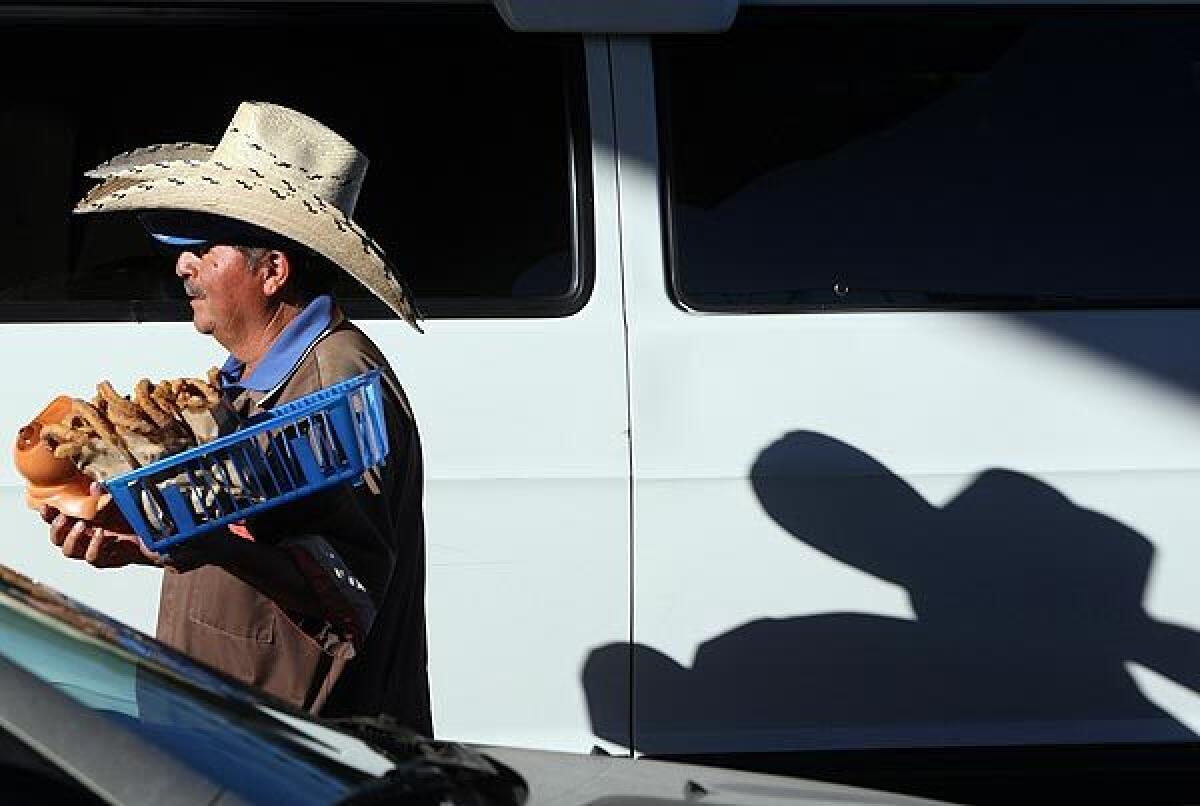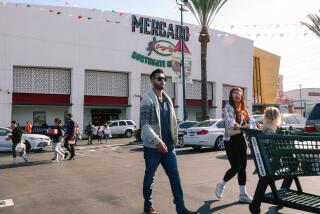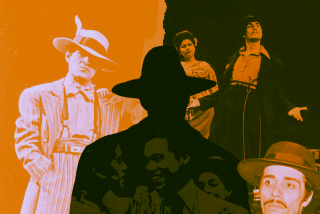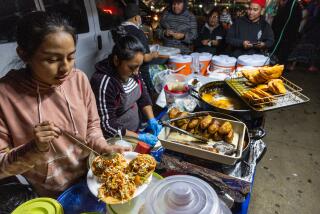Trying to get ahead in the slow lane

El Churrero -- the Churro Man -- sidesteps tamale carts, squeezes between bumpers and beggars, working 24 lanes of idling vehicles.
He walks through shimmering exhaust clouds, hawking sombreros teetering atop his head and sweets held aloft in a blue basket. His churros are warm and moist. “Churros here,” he yells. “If they’re not hot, you don’t pay.”
Deciderio Mauricio Cantera first waded into the sea of traffic at the gateway to California in 1968 and set eyes on the bored and the hungry as they waited, fidgeted and honked, inching toward the San Ysidro Port of Entry.
This isn’t a traffic jam, thought Mauricio. This is a swap meet on wheels.
Over the years, Mauricio has peddled Popsicles and pumpkin piñatas, checkered blankets and flowery ceramic vases, Tweety dolls and Little Mermaids. In the 1960s, plaster busts of John F. Kennedy were big sellers; in the 1990s, Michael Jordan piggy banks.
To American border crossers, the ragtag knots of vendors have long evoked wonder, pity and annoyance -- symbols of disorder and desperation at the shabby entrance to the developing world.
Mauricio and the others are actually regulated by a vendors union formed decades ago to impose order, and to guarantee the safety and cleanliness of the food sold. He wears the vendors’ light brown uniform, faded, but clean.
He is one of 500 vendors assigned to different areas along the network of roads, overpasses and bridges leading to the border. Few ever stray out of their assigned territory. Mauricio can sell only along the 300-meter stretch from the international boundary to the Libertad Bridge.
His union badge displays his name, picture and product. “Churros,” it reads.
“It’s a dignified job. We all earn an honest living here,” Mauricio said in Spanish.
Walking the lanes from 8 a.m. to midnight six days a week in earlier years, Mauricio stuffed his pockets with crumpled dollars and pesos. He bought a hillside lot and built a one-bedroom cottage. Later, he built a larger house. He sent three of his four daughters to college and trade schools in Tijuana. In his spare time, he ran through the pitted hills and finished several marathons, including the one in Los Angeles.
These days, the region’s weak economy and crime and the heightened security at the border have eroded sales. As a result, Mauricio works fewer hours each day but he is not discouraged. He knows that patience pays off.
Mauricio, 59, still runs every morning -- the exercise, he says, purges his lungs of the carbon monoxide he breathes -- and then returns to the border for another mini-marathon of peddling.
“Fatigue? It doesn’t exist. It’s only in your head,” he said.
In the mid-1960s, Mauricio’s impoverished parents from the Mexican state of Querétaro moved the family to Baja California, following an uncle who was selling baby chairs at La Linea La Linea -- the international boundary.
Mauricio’s friends encouraged him to keep going north to California, where the economy was booming. He refused. “It was easy to cross in those days,” he said. “But I wanted to feel free, not the stress of being illegal.”
Mauricio had only two years of schooling and could barely read or write, but he knew numbers and he had a creative side. He worked non-stop for a few years manufacturing trinkets and figurines for his uncle and other vendors. He saved his money. At 18, he paid $1,500 for his own vendor license and headed into the traffic.
Tijuana in the ‘60s was entering its golden age of tourism. People flocked to the bullfights and bars, the horse races and the red light district. American tourists, Mauricio quickly found, had an insatiable appetite for cheap Mexican crafts and all things kitschy.
He sold piggy banks of all sizes, shapes, colors and themes. He imported ceramic from Guadalajara and blankets from Querétaro. He got up at 4 a.m. to paint flowers on clay pots and whiskers on plaster Santa Clauses with brushes he made from hair he snipped off stray cats.
“The back hair is the best,” Mauricio said. “Perfect for painting fine lines.”
He kept a pulse on American pop culture, dreaming up products that reflected the times or season. At one point, he employed eight people who manufactured plastic figures of popular icons. “Michael Jordan made me a lot of money,” Mauricio recalled.
He sold to children, surfers, hippies and retirees. Items that cost him $1 he sold for $5 ($3 for hard bargainers). Some days he earned as much as $200. His steadiest customers were the sailors and Marines from San Diego-area bases. They’d wobble back to the border after long nights in the raucous tequila bars, Mauricio said. “It looked like the march of the penguins. They’d go home drunk, hugging my piggy banks.”
Mauricio opens the creaky metal gate to his house in Tijuana’s El Soler neighborhood, 10 miles from the border. The cracked driveway is flanked by two stucco cottages. In the back, past the rows of multi-colored clotheslines, sits a two-story brick home with fading paint and a peeling front door.
In the early 1980s, when the peso suffered a devaluation, Mauricio emptied his savings account of dollars and traveled to Querétaro, where he bought as many factory-made blankets as he could and shipped them to Baja California.
Hundreds of sales later, Mauricio counted out a small fortune: $20,000. He had tripled his money and earned enough to build a larger home for his growing family. The house lacks heat, but Mauricio says the bricks keep it well insulated. In the living room, there’s an old television set, a first-place running trophy on a shelf, and a picture of Mauricio’s first wife hanging on a wall. She died of leukemia in 2003.
“There’s nothing like a first wife,” said Mauricio, who remarried and has since divorced.
The home remains a work in progress. The staircase lacks rails, and he never finished the upstairs bathroom. Mauricio would like to replace the frayed carpets and clean out the piles of scraps from the rear yard, but money ran short, he said, when the border started changing.
The once mighty iron river of cars that funneled through the San Ysidro Port of Entry has receded sharply. America went to war in the Middle East in the 1990s, suffered a terrorist attack a few years later and grew uneasy with rising levels of illegal immigration. Another war came. With each passing year, security at the border has grown tighter.
More rigorous inspection procedures increased wait times, discouraging Southern Californians from taking short trips to Mexico. Military restrictions curbed visits by sailors and Marines. Then came the drug war and the swine flu. The crowds of American tourists thinned. At the same time, fewer Mexicans were going into San Diego to work or shop.
The number of people crossing from Tijuana into San Diego dropped from 47.4 million in 2003 to 34.7 million last year, according to Customs and Border Protection. Vehicle crossings declined from 17.5 million to 14.2 million.
The customers that sustained Mauricio for decades were dwindling.
Mauricio arrives at his friend’s churro stand every morning by 10. Shielded from the sun by a canopy, it sits on the median strip dividing the 24 lanes of traffic, a perfectly-situated home base.
Mauricio turns the jury-rigged steering wheel, and the attached metal rod spins, pushing the dough through a tube. Out drop the sticks of dough into a boiling pot of oil. Mauricio fishes them out, sprinkles on cinnamon-sugar and bags them.
He sets out into the crush of traffic.
His fellow vendors peddle products that fit every taste. Food carts are gorged with lollipops, sodas, peanuts, candied apples and potato chips. There are newspaper hawkers, flower girls, window wipers and a man who sells calling cards and car insurance.
Mauricio makes change for a young man who sells coffee, yells to a frozen yogurt runner that he’s got a customer, and greets his paralyzed friend, Antonio, who tucks his disabled legs on a scooter, a box of Chiclets in his lap. Eliseo Hernandez, a mango ice cream vendor, said he’s worked with Mauricio since the 1970s, when the then-asphalt roadway left shoes ragged after two weeks. “Mauricio has never lost his focus,” said Hernandez, 59.
Many vendors, Mauricio included, don’t offer much in the way of souvenirs anymore. Everyday goods are what sell these days to primarily Mexican customers. The sombreros atop Mauricio’s head are for the gardeners and others who work outdoors. He sells sleeves to women so their arms, resting on windowsills, don’t get sunburned while they wait in traffic. But churros are his main product.
“Churros calientitos” -- hot churros -- yells Mauricio, as he walks through the cars jockeying for position. The air is foul. Spanish-language talk radio, Ranchera music, hip-hop and hard rock filter out from the vehicles. Mauricio keeps an ear on the grunts and starts of vehicle engines behind him. “You have to be like the bullfighter; ready to move away.”
It’s 2 p.m., three hours since he started walking. Mauricio hasn’t made a single sale.
He keeps walking. A friend sees him: “Hola, Churrero.”
An hour later, a woman honks. Mauricio hustles over. She gives him $2. Mauricio notices two children sitting in the van. Instead of giving 50 cents change, he gives her another bag. “You’re lucky. There’s a sale today,” Mauricio says.
Hour after hour, Mauricio keeps walking, up one lane and down the next. Up another and down again. He ascends a winding overpass, and descends a ramp. He passes by several vendors resting under palm trees. They are the sons and grandsons of original union members, men as well as boys half his age. They look exhausted.
Mauricio walks right by. “In this life, you have to keep moving. . . . How are you going to sell if you don’t work?”
Now, on a good day, Mauricio earns $15. (He sells each bag for $1.50: His profit is $1; his partner who helps make the churros gets 50 cents.) Today it is unlikely he will make that much. After five hours, he has sold only three bags.
Worrying is pointless, Mauricio says. “There are hungry people out there. I just have to find them.”
The Churro Man plunges into the traffic again. There are 12 more lanes before him, and the cars keep coming. “You have to go round and round and round,” Mauricio says. “That’s life.”
More to Read
Start your day right
Sign up for Essential California for news, features and recommendations from the L.A. Times and beyond in your inbox six days a week.
You may occasionally receive promotional content from the Los Angeles Times.







